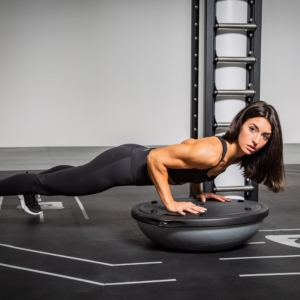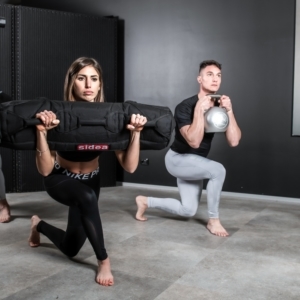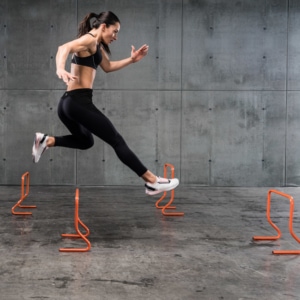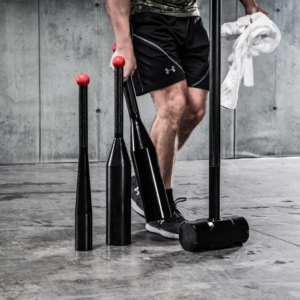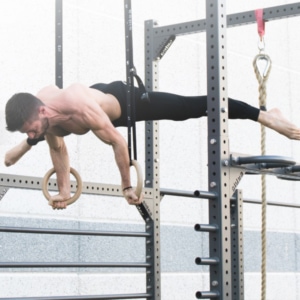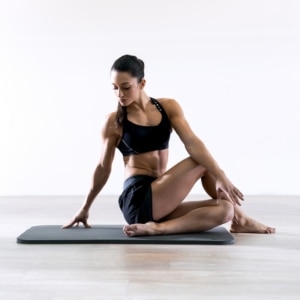🇮🇹 Leggi in Italiano
Sudden changes of speed and direction, an extremely high-intensity athletic performance which take place on an unstable floor as a snowy track: snowboard, led to competitive levels, requires an important athletic preparation not only to reach the athlete’s maximum potential, but also to avoid injuries and possible damages, and Nadya Ochner must surely be conscious about all of this.
The 25 year old snowboarder has recently participated to the Winter Olympic Games in PyeongChang wearing the Italian colors, and about the physical preparation for this sport has declared: “In my opinion, functional training plays a key role in snowboard athletic preparation, because it allows to train different muscles from the usual, including the smallest ones which are extremely important as they help to stabilize the whole muscular system. In a snowboard performance stability is one of the most useful features to work on, especially when the track is ruined: in similar situations, stability becomes essential as it allows not to suffer every irregularity of the track, helping to avoid falls during the competition. In general, the more one is stable and able to control his own movements on the track, the faster he will be. About functional training there are different opinion in this sport: some athletes and coaches do not use it during the preparation, but it’s a small part them. Personally, while doing it I perceived that it was very positive for my performance, so I’m totally in favor”.
Nadya ‘s training and snowboard preparation steps
Snowboard preparation is obviously differently articulated during the course of the year, varying in the train modalities and in the intensity as the winter sports season approaches: “On average, I train for 5 hours a day, 5-6 days a week – Nadya has continued – On summer I start with an athletic preparation of at least 1h30 (up to 3 hours in some cases) in the morning and as many in the afternoon. For what concerns functional training, I concentrate mostly on proprioceptive exercises on unstable bases (like Duneball, balance boards and pads, Flying etc.) in combination with light weights or with a Flow Bag, so that I can mainly strengthen my legs, the abdominals and the adductors. From September onwards the rhythm of the trainings changes, because I start to work on the snow: about 3-4 hours of snowboard in the morning and 1-2 hours in the afternoon. I used this training schedule also to prepare for the Olympic Games, because I think it is very good for my physic”.
The results and the origin of the passion for snowboarding
Already part of the Italian Olympic Team for Sochi 2014 edition, Nadya Ochner participated also to three World Cups in her career (Stoneham 2013, Lachtal 2015 and Sierra Nevada 2017), reaching the podium six times and winning three times in the Parallel-Mixed-Team-Slalom. Her passion for the snowboard has origins far in time: “When I was 5 I used to see my father on tracks as he trained with his friends and I liked it so much that I wanted to try it too. I still remember the falls and the tears while I was learning to use the snowboard, but I never wanted to stop: I wanted to improve, and I still want it”.
Nadya’s future goals
About this, Nadya has also set the target for her future challenges: “My next main goal is the World Cup that will take place in Park City in February 2019. I’m trying to get prepared both athletically and technically for this event, so that I can reach an optimal condition for the first snowboard competitions in December”.
The “Five Must”: Functional Training for the snowboard
As Nadya said, snowboard is a sport of balance, stability, but also strength and reactivity of movements. That’s why functional training can play an essential role by preparing the athlete and by providing him the bases on which he can then build technically. For this reason, before to start specific trainings on the sport’s movements, it is fundamental to work on the joint mobility, the proprioception and the general strength. In this step of the preparation, the athlete should make exercises on unstable bases, using tools like Flying and Flowbag, exactly as Nadya said in the interview. In a second moment the athlete can pass to the subsequent steps of the preparation, working on more specific target which can be located by studying the typical recurrent movements of the sport. In this case, the “Five Must” identified by the WTA Trainer Evgenia Babrovskaia (already athletic trainer of the Italian snowboarder Corinna Boccacini) for this sport are Flyo Side Balance, Kettlebell Side Skiing Squat, Kettlebell Swing, Flowbag Front Snatch & Lunge and Flowbag Side Swing & Halo.
- Flyo Side Balance: this exercise is perfect to introduce to the control of one’s own center of gravity while making a dynamic movement on unstable base. The board’s features make it particularly indicated to reproduce the conditions of snow sports.
- Kettlebell Side Skying Squat: it allows to train on transferring the core of the movement on the transverse plane to the hips, keeping instead as stable as possible the knees, that otherwise could be damaged and cause injuries to the ligaments.
- Kettlebell Swing: it can be included in a generical preparation program, as it is able to complete the flexion and extension movement of the hips, that perfectly reflects snowboard’s alternating movement of slalom. Through this exercise in fact it is possible to train the power of the extension of the hips.
- Flowbag Front Snatch & Lunge: it allows to coordinate the hips and the shoulders on sagittal and frontal planes, improving the control of the body center of gravity, so that it can contrast the instability.
- Flowbag Side Swing & Halo: it connects the lower and the upper parts of the body, but in this case in the transversal plane, which is more complex than in the Front Snatch & Lunge but that is particularly exploited in the snowboard. In this way it is possible to coordinate the power of the hips (Swing) with a work on the mobility and on the traction strength of the shoulders (Halo).


